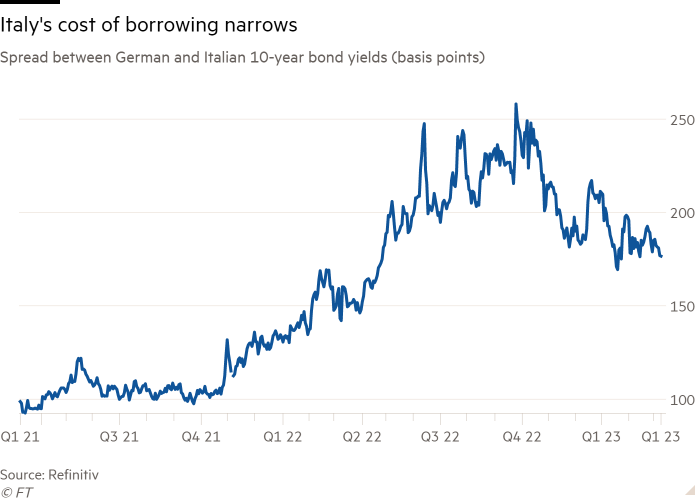[ad_1]
Investors expect the European Central Bank to accelerate the shrinking of its balance sheet this summer, testing their appetite for eurozone sovereign debt as cash-strapped governments also turn to markets to raise funds.
The shift by the ECB to tighten its policy stance is likely to drive up government borrowing costs in more heavily indebted southern European countries once “investor fatigue” from more bonds flooding the market sets in, some analysts warned.
This month the ECB started to reduce its bond holdings by not replacing €15bn of the securities that mature each month in its asset purchase programme, which makes up two-thirds of the almost €5tn of assets it has purchased under its longstanding policy of quantitative easing. Debt markets were unperturbed by the Frankfurt-based institution starting to reduce its bond holdings this month.
But eurozone governments issued about €100bn of extra debt — above that needed to refinance maturing bonds — in January and again in February, according to Camille de Courcel, head of strategy for G10 Rates Europe at French bank BNP Paribas. “We have this very strong supply [of new debt] and we think there will be some kind of indigestion in the market and then we could see some underperformance,” she said.
Overall borrowing costs for eurozone governments have risen sharply in the past year as the ECB has reduced its bond purchases and raised interest rates. But the difference, or spread, between the cost of borrowing for heavily indebted countries in Europe’s periphery, such as Italy, and those of safer “core” countries such as Germany has narrowed in the past six months.
Since Giorgia Meloni’s election as head of Italy’s rightwing government, she has surprised investors by taking a relatively cautious approach to public spending, calming anxiety about the country’s high debt levels. “Meloni is more fiscally prudent than initially thought,” said Ludovic Subran, chief economist at German insurer Allianz.

Italy’s 10-year bond yield was 4.42 per cent on Wednesday, close to its highest level for almost a decade. The spread with its German equivalent, however, was just below 1.8 percentage points — after falling from levels above 2.5 points last year.
This seems an anomaly to some economists, who expected rising interest rates to cause the spread between riskier assets and less risky ones to rise. “The stability in peripheral spreads in the face of the fastest monetary tightening cycle ever, and re-pricing of the terminal rate higher, looks puzzling,” said Frederik Ducrozet, head of macroeconomic research at Pictet Wealth Management.
However, analysts said higher yields on longer-term Italian government bonds were attracting more investors, helping to compress spreads. Piet Haines Christiansen, director of fixed-income research at Danske Bank, said this had started to “attract a certain investor base that has been absent in the past many years during the low interest rate environment”.
For example, Rabobank researchers calculated that asset managers, insurers, pension funds and households “stepped up” to absorb €30bn of Italian sovereign debt sold by banks and foreign investors around the time of last October’s election.
“Italy is the one we’re watching fairly closely,” said Michael Metcalfe, head of macro strategy at State Street, adding that private sector investor demand for Italian government debt had held up well.
“Is confidence beginning to wobble? We’re not really seeing anything,” Metcalfe said. “The [ECB policy] tightening we’ve had has been well flagged, so markets have had time to adjust. But it’s worth being cautious. Quantitative tightening will be a long process.”
But others still think Italy’s borrowing costs are still likely to rise. Sophia Oertmann, an analyst at DZ Bank, calculated that to avoid a “vicious circle” of rising debt and borrowing costs Italy needs to return to a primary budget surplus — excluding interest costs — something it has not done since 2019. Without this “a psychological tipping point would then also be reached”, she said, pointing to rating agencies updating their scores for Italy in April and May as a possible “catalyst”.
Encouraged by the smooth start to shrinking the ECB’s bond portfolio, some of its governing council members, such as Bundesbank president Joachim Nagel, have called for the central bank to speed up the quantitative tightening process when this is reviewed in July.
Others, such as Austria’s central bank head Robert Holzmann, have even said it should bring forward from the end of next year the start of a reduction in its separate €1.7tn portfolio of bonds bought under an emergency scheme launched during the coronavirus pandemic.
To go even faster, the ECB could sell bonds before they mature, but most analysts think this is unlikely as it would crystallise big losses.
Konstantin Veit, a portfolio manager at bond investor Pimco, said he expected the ECB to stop replacing all maturing bonds in the APP from July, which would increase the monthly reduction in its holdings to €25bn.
“The main consequence is increased government bond supply to the market,” said Veit. Normally, he said, such a shift “probably doesn’t matter that much, and higher yields typically makes fixed income more attractive”. However, this could change in a political or economic crisis, in which case “the market might take a closer look at supply dynamics.”
Most investors think the private sector has enough capacity to mop up the extra supply of bonds this year, but only if inflation declines roughly in line with expectations.
“Last year the ECB helped reduce net bond supply, this year the ECB will add to it, likely taking the net bond supply to over €700bn, from something around €150bn last year,” said Derek Halpenny, head of research for global markets at MUFG. “If inflation were to prove notably higher than expected that could create problems.”
[ad_2]
Source link
